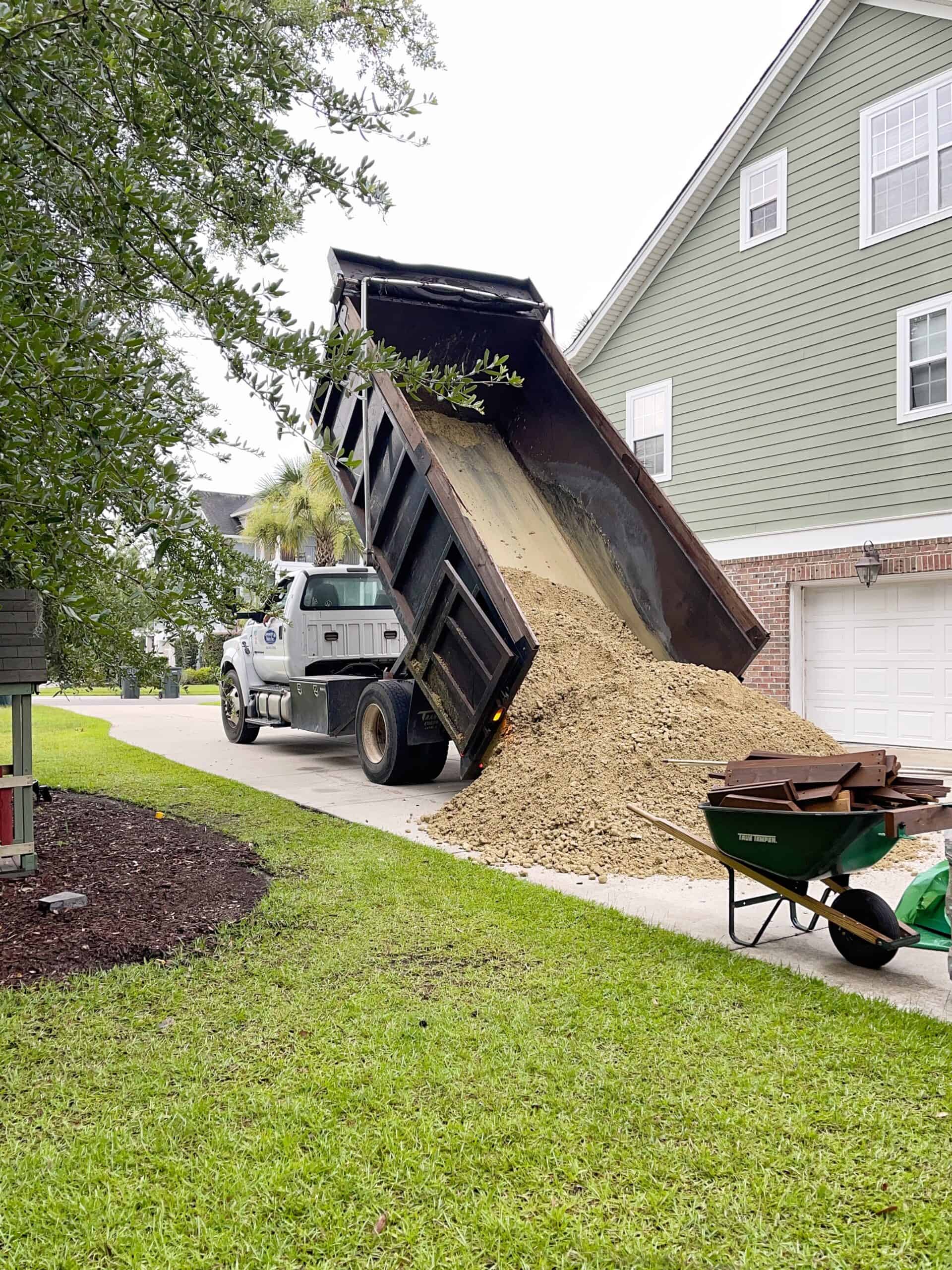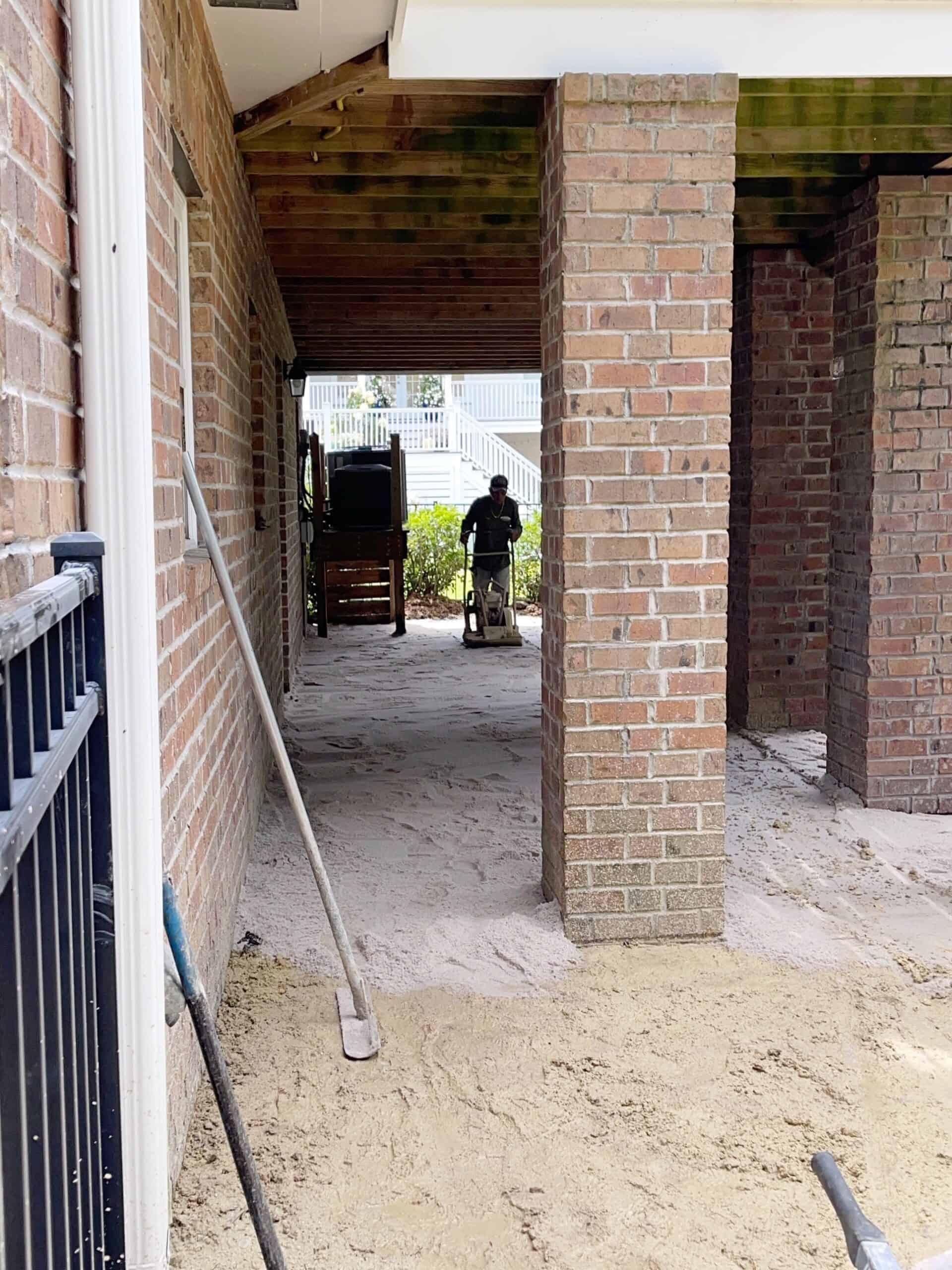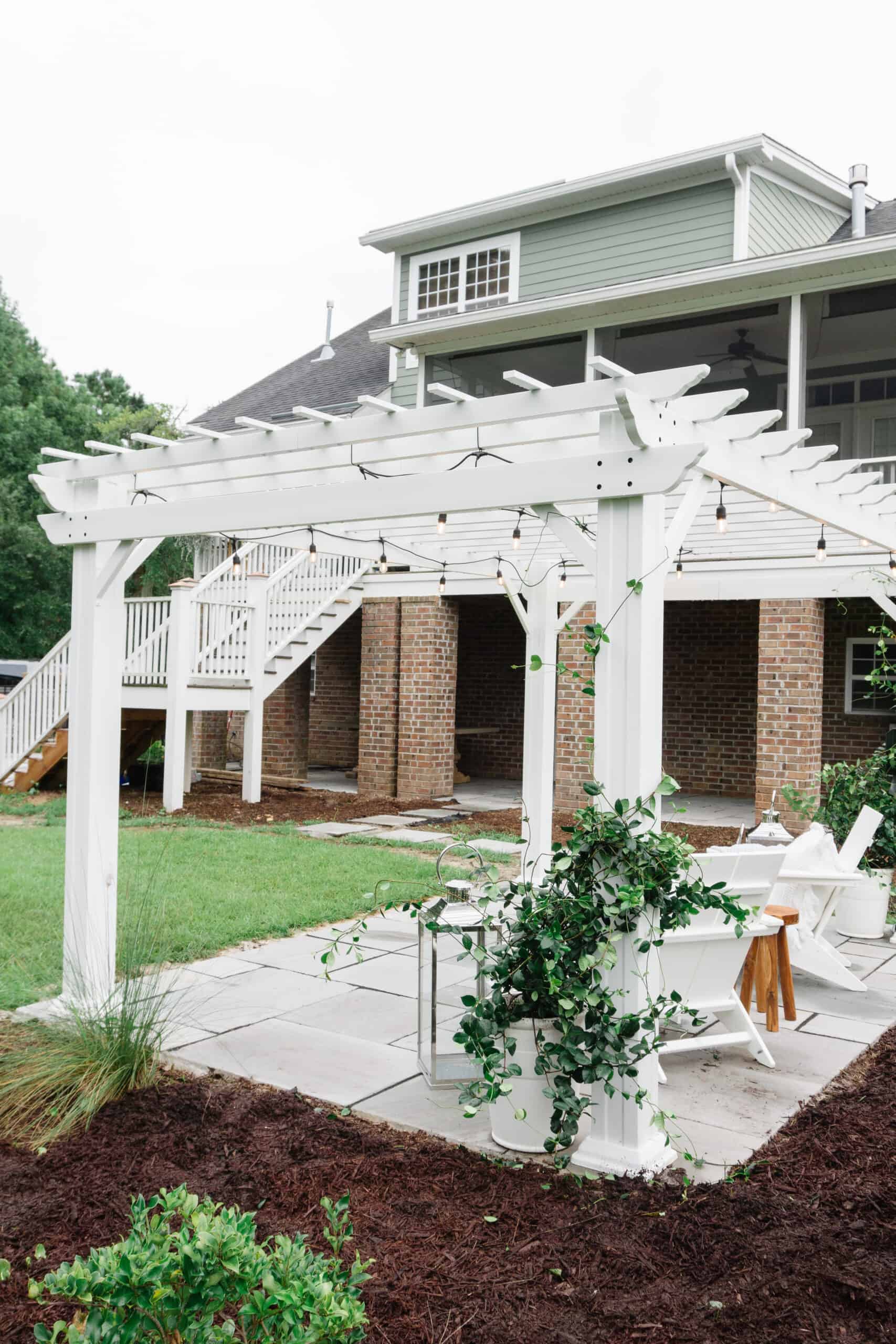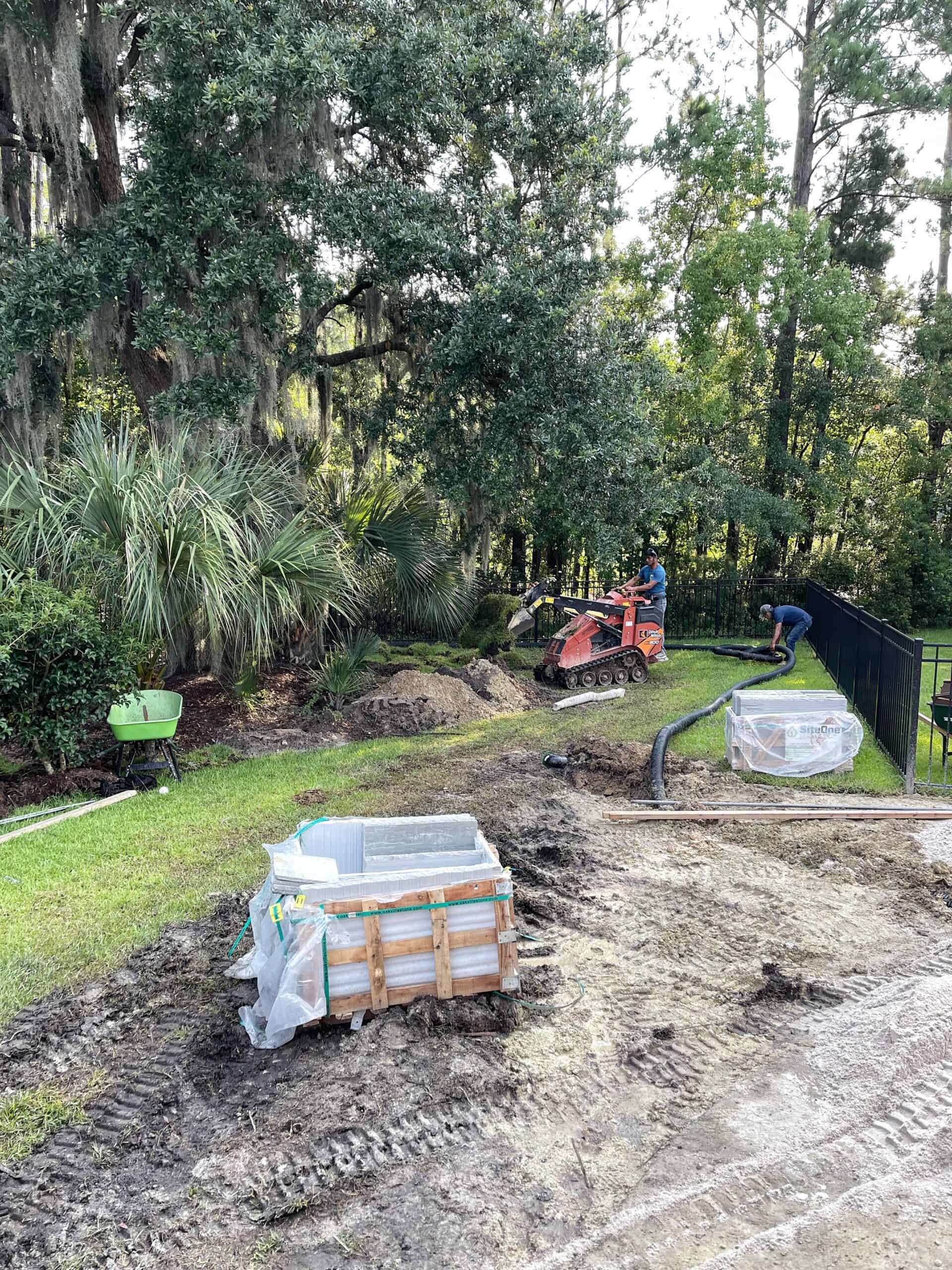Castle Grey Flagstone Patio
We recently designed a new flagstone patio in our backyard knowing it would be a functional and simple way to update the space. We chose flagstone for many reasons, including its durability, the minimal maintenance requirement, and how it looks with our home exterior.
Since we’ve installed our family-friendly patio, it has tremendously benefitted our family by creating a space where the kids can run and play and can be easily hosed off daily! We’re so excited for the backyard makeover, and we can now invite guests to sit around our fire pit while the kids play.
Are you considering new hardscaping for your patio or backyard? If you’re looking to create a flagstone patio or walkway, keep reading to learn why we installed natural cleft and cut Castle Grey flagstone in a French pattern.
What Are Flagstone Pavers?
Flagstone is a sedimentary stone that occurs when sediment layers harden, usually underwater. It is composed of layers of strata of sand, clay, or organic sediments. When you hear the term flagstone, think of it as an umbrella encompassing several different types of stone. You will find common varieties of flagstone like slate that is popular in interior spaces, bluestone that is frequently found in cooler climates, and castle grey that is often used in exterior spaces. I’m going to discuss my two favorite varieties next: Castle Grey Flagstone and Bluestone.
Different Types of Flagstone
Castle Grey Flagstone
Castle Grey flagstone is neutral in color with light blue to dark grey undertones. It has hand-cut edges and a naturally uneven surface, giving it a beautiful texture. This type of flagstone is extremely low maintenance and highly durable.
Bluestone is a Type of Flagstone
Before I started researching different types of backyard pavers, I was unaware that bluestone is an actual type of flagstone. The thought was very confusing to me. Remember, there are numerous types of flagstone and bluestone is one of them. Bluestone is formed when particles deposited by rivers, oceans, and lakes are fused together. Bluestone guarantees a timeless look, especially among plants and other greenery.
Why We Selected Castle Grey Flagstone
Now that we’ve discussed flagstone and the several different varieties, it’s important to note that I really wanted bluestone for our home. When I started pinning inspiration photos, I pinned several dreamy homes with bluestone patios. At this point, you may be wondering why we chose castle grey flagstone over bluestone. I personally love the charm and look of bluestone and have always dreamed of having it in our backyard. However, several professionals warned against using it in a warm climate because it gets really hot underfoot. Living in Charleston, South Carolina, we have several hot months and need a stone that is family-friendly for backyard play. We did not want to worry about spraying it with water to cool it down each time we planned to go outside to play or entertain.
Also, when comparing other popular paver options for our patio project, we found that several are slick when wet which would not be the best choice with children. The natural texture of grey flagstone makes it less slippery and is a safer option for our family.
Finally, while castle grey flagstone does not have the same color-variation as bluestone, it’s the closest in appearance to get the desired look. I really wanted to create depth and variation in the design, and I found that many other stones were all one color. They blended together and lost that “let’s take a walk down a charming garden path” vibe.
Pros and Cons of Castle Grey Flagstone
Pros:
Cons:
When and Where to Use Flagstone
Flagstone is a great for interior and exterior spaces. You will find several varieties used in interior design, like fireplaces and even some floors. However, flagstone is most commonly found in exterior spaces. The process used for installing our flagstone is not recommended for driveways and we were advised to use caution when pushing a wheel barrel and or driving over it with a lawnmower.
Before Flagstone Installation
Our backyard was a complete mess prior to starting this project. When designing our exterior makeover, we wanted to install a flagstone patio for our family to enjoy. Our grass was dead in one section where our DIY raised garden once sat. The flower beds were overgrown with weeds. The worst part, our main flowerbed morphed into a pond with each heavy rain. Each spring, nuisance water weeds sprung to life and the standing water attracted more mosquitos. It really was a mess and time to give it a functional overhaul.

Installing Flagstone
For this project, we opted to hire professionals to ensure proper installation. We were very happy with Coastal Outdoor Solutions with this installation. I was present for the entire project with a pen in hand to take notes and discuss the installation process with you. From prepping the yard for flagstone installation to finishing with concrete and joint material, the process is outlined below.
Installation Overview
First, the team used their heavy machinery to remove the grass and dirt, then created a level surface. Then, they prepped the surface and installed several inches of compacted base material. They screed out a sand setting on top of the compacted base material. Next, they set out to install the flagstone in an irregular pattern. This process took a few days because they had to use a saw and cut several stones to fit around our pillars. Once the stone was in place, they poured a concrete edge around the outer perimeter to hold the stone in place. Finally, they added joint material to lock the stones in place.
How to Install Flagstone
- Remove grass and dirt to create a level surface.
- Install 3-4 inches of compacted base material.
- Scree out a 1-inch sand setting bed.
- Install flagstone in irregular pattern.
- Install a concrete edge to hold the outer perimeter.
- Add joint material.

Grass and dirt removal to prep the surface.

Joint Material
Once the pavers were in place, it was time to add joint material. Gator Nitro Joint Sand was recommended to finalize the project. Joint material, or in the case joint sand, is a ready-to-use mixture of calibrated sand and resins which cure when exposed to air, hardening from top to bottom of the joint. It can be applied in wet weather and is permeable. Given our wet and humid conditions in South Carolina, this joint sand is guaranteed to not moss, mold, or mildew. Selecting joint material is important because it’s what goes in between the stone and shows in the cracks. It is available in three colors, beige, black, and grey. We went with grey because the black was really dark and the beige had a red tint in color.


If it’s in your budget, I recommend opting for a mudding technique to achieve more of a classic look. When we received quotes for a white mudding, it tripled the cost because it is much more labor-intensive. We went with grey joint sand to save money, and I was worried about the darker color between the stones. The joint sand was only available in grey, reddish-brown, and black, so went with grey and played it safe.

That entire process sounds easy, right? Not at all. Honestly, I do believe this is a project for professionals and not a DIY project. They used heavy machinery and 5-6 skilled workers that completed the project in a few days. From measuring and ordering the materials, to cutting the stones to fit our pillars, their skill was needed for this project.
Flagstone Pattern
There are several patterns to choose from when laying flagstone. First, it depends on the type of stone that you purchase. We selected various sizes of rectangle stones and had them installed in an irregular or random pattern. This is often referred to as a “French pattern.” Asymmetrical is another option that is popular and stunning. The stones arrive in a more jagged cut and they have a natural appearance when set using the mudding technique.


Flagstone Walkway and Stepping Stones
There is something so magical about walking along a path to a jasmine-covered pergola. When we designed this project, we included a flagstone walkway with stepping stones to our new pergola. The next step in the process will be adding grass between the stones and to the walkway. I remember skipping along stepping stones as a child and how they felt so cool underfoot. You will see that we opted for a straight pattern using stones of the same size.
Flagstone Questions
Is a flagstone patio expensive?
As far as flagstone cost goes, castle grey flagstone is definitely less than bluestone, however, it’s more expensive than most paver styles. It’s more comparable to ivory or Noche Travertine in terms of price. The price per square footage varies on your location and source availability.
What do you put between flagstone pavers?
While there are several options to put between flagstone pavers, polymeric sand is most commonly used. Our professionals recommended Gator Nitro Sand which is calibrated sand and resins that cure when exposed to air, and harden from top to bottom of the joint. When flagstone is used a walkway or path with single stones, you will sometimes see pea gravel or grass used between the stones.
How do you select a pattern for your flagstone?
This depends on your personal preferences. For this project, we loved the look of a random or irregular pattern aka the French pattern using different sizes of stones.
What do you put under flagstone pavers?
Depending on the size and style of your pavers, they can be applied directly to sand and dirt. If you’re installing thinner slabs of stone, you’ll need to provide a solid base to avoid deterioration. You will also see flagstone placed in the wet mortar, which is the mudding technique that is more expensive.
Are flagstone pavers slippery?
When selecting flagstone for our project, I wanted to make sure we selected a stone that was not slippery. All stones are naturally slippery when wet, but some varieties are worse than others. Castle grey is naturally textured and not as slick as other options. In addition, our installation team recommended against sealing our flagstone patio because that can cause the stones to become very slippery when wet.
What kind of maintenance is required for flagstone?
When caring for your flagstone patio, it’s important to keep standing water off of the stones. You will need to make sure that you have a proper drainage system and slope to keep the water from standing. Mineral deposits in the water can cause spots and discoloration with time. It’s important to remove debris and leaves frequently. Again, if they get wet and sit for a long time, they can cause spots. Clean the stones routinely, just make sure you use an approved cleaning product for flagstone.
















